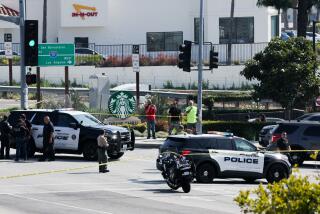Officers at Risk Despite Armor
LAPD Officer Kristina Ripatti was wearing a standard issue bulletproof vest when a suspect shot her Saturday, but a bullet managed to slip through a vulnerable section of the body armor, authorities said Monday.
The bullet, fired by a fleeing robbery suspect, struck the 10-year veteran in the left armpit, just above the top of her vest. The unprotected area, which is problematic to cover, is common to body armor, police officials say.
“The question is, ‘Can we cover that area?’ Well, probably not,” said Lt. Paul Vernon, a Los Angeles Police Department spokesman and Ripatti’s former supervisor. “How are you going to cover your armpit and still be able to drive a car and handcuff people and move?”
The LAPD’s body armor is supposed to protect an officer’s torso against a .22-caliber bullet, the type allegedly fired by James Fenton McNeal. But this bullet found its way around the armor. Ripatti, 33, is in critical but stable condition at California Medical Center.
“What can I say? Bullets do strange, strange things,” Vernon said.
The department’s SWAT teams wear heavier, more extensive armor, designed to protect against a variety of weapons. But the SWAT gear is designed for short, intense periods that have already turned hostile. They wouldn’t work for everyday cops on routine patrol, said Police Chief William J. Bratton.
“You cannot totally surround an officer in Kevlar,” Bratton said after a banquet at the Los Angeles Police Academy in Elysian Park.
An officer “could not function in a 12-hour day wearing those vests,” he said.
The vest Ripatti was wearing looked like a tank top but had a protective material covering the chest, stomach, ribs, back and kidney area. Her neck and arms were not protected.
Ripatti and her partner, Officer Joe Meyer, chased McNeal, 52, on foot after he ran in front of their patrol car at LaSalle and Leighton avenues near USC about 10:30 p.m.
Police said that McNeal, who had prior convictions for armed robbery and murder, turned and fired five shots -- one of which injured Ripatti. Meyer returned fire, hitting McNeal, who died at the scene.
Ripatti sustained heavy blood loss and massive injuries to the left side of her chest and left lung. Her husband, Officer Tim Pearce, 38, was one of the first to respond to the scene of his wife’s shooting. The couple have a 15-month-old daughter.
The department supplies vests made by Michigan-based Second Chance Armor Inc. to officers who request one. They are encouraged to wear a vest on patrol and required to do so during certain actions, such as serving a search warrant, said LAPD Sgt. Lee Sands.
Officers can upgrade to heavier armor if they pay the difference in cost. All levels of Second Chance armor have the same basic life-preserver shape -- protecting the chest, stomach and back -- and are equally vulnerable to the shot that injured Ripatti.
Vernon said most officers wouldn’t want to wear anything bulkier or more obvious on routine patrol. “It’s a balance between cost, practicality, comfort, appearance and the kind of message you want to send to the community,” he said.
Second Chance came under intense criticism in 2003, when it was discovered that the ultra-strong Zylon synthetic fibers inside the armor were at risk of degrading rapidly. The company recalled thousands of vests and replaced those used by the LAPD. The company has since declared bankruptcy.
Mayor Antonio Villaraigosa called the shooting of Ripatti “a tragedy for our city.”
Villaraigosa noted that LAPD officers have been fired upon 19 times since he took office nearly a year ago.
“This is outrageous and unacceptable,” he said in a statement. “Gun violence is nothing less than a plague on our society’s most vulnerable.”
*
Times staff writer Arin Gencer contributed to this report.
More to Read
Start your day right
Sign up for Essential California for news, features and recommendations from the L.A. Times and beyond in your inbox six days a week.
You may occasionally receive promotional content from the Los Angeles Times.






